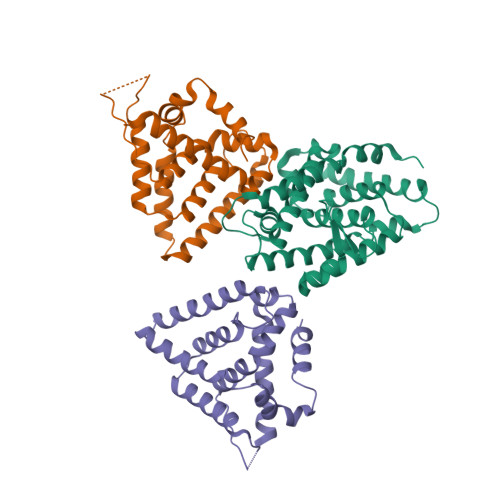Contents:
- Gene and Protein Information
- Previous and Unofficial Names
- Database Links
- Selected 3D Structures
- Natural/Endogenous Ligands
- DNA Binding
- Co-binding Partners
- Main Co-regulators
- Main Target Genes
- Tissue Distribution
- Phenotypes, Alleles and Disease Models
- Clinically-Relevant Mutations and Pathophysiology
- Gene Expression and Pathophysiology
- Biologically Significant Variants
- General Comments
- References
- How to cite this page
Gene and Protein Information  |
|||||
| Species | AA | Chromosomal Location | Gene Symbol | Gene Name | Reference |
| Human | 470 | Xp21.2 | NR0B1 | nuclear receptor subfamily 0 group B member 1 | 21 |
| Mouse | 472 | X 39.67 cM | Nr0b1 | nuclear receptor subfamily 0, group B, member 1 | 18 |
| Rat | 472 | Xq21 | Nr0b1 | nuclear receptor subfamily 0, group B, member 1 | |
Previous and Unofficial Names  |
| AHC | DSS | AHCH | adrenal hypoplasia, congenital homolog | AHX | nuclear receptor subfamily 0 |
Database Links  |
|
| Alphafold | P51843 (Hs), Q61066 (Mm), P70503 (Rn) |
| ChEMBL Target | CHEMBL1795094 (Hs) |
| Ensembl Gene | ENSG00000169297 (Hs), ENSMUSG00000025056 (Mm), ENSRNOG00000003765 (Rn) |
| Entrez Gene | 190 (Hs), 11614 (Mm), 58850 (Rn) |
| Human Protein Atlas | ENSG00000169297 (Hs) |
| KEGG Gene | hsa:190 (Hs), mmu:11614 (Mm), rno:58850 (Rn) |
| OMIM | 300473 (Hs) |
| Orphanet | ORPHA123902 (Hs) |
| Pharos | P51843 (Hs) |
| RefSeq Nucleotide | NM_000475 (Hs), NM_007430 (Mm), NM_053317 (Rn) |
| RefSeq Protein | NP_000466 (Hs), NP_031456 (Mm), NP_445769 (Rn) |
| UniProtKB | P51843 (Hs), Q61066 (Mm), P70503 (Rn) |
| Wikipedia | NR0B1 (Hs) |
Selected 3D Structures  |
|||||||||||

|
|
||||||||||
Natural/Endogenous Ligands  |
| Comments: Orphan |
Co-binding Partners  |
|||
| Name | Interaction | Effect | Reference |
| Steroidogenic factor 1 | Physical, Functional | Inhibition of SF-1 dependant transactivation by recruiting the nuclear receptor corepressor NCOR1 to SF-1 | 3,15 |
| Liver receptor homolog-1 | Physical, Functional | Inhibition of LRH-1 dependent transactivation | 15 |
| Estrogen receptor-α | Physical, Functional | Inhibition of ER dependent transactivation | 23 |
| Androgen receptor | Physical, Functional | Cellular localization, DAX-1 also potently inhibits ligand-dependent transcriptional activation. DAX-1, known to shuttle between the cytoplasm and the nucleus, is capable of relocalizing AR in both cellular compartmentsR dimerization | 1,6 |
| Progesterone receptor | Physical, Functional | Inhibition of PR ligand dependent transactivation via destabilization of the receptor dimers | 1 |
Main Co-regulators  |
||||||
| Name | Activity | Specific | Ligand dependent | AF-2 dependent | Comments | References |
| NCOR1 | Co-repressor | No | No | - | 4 | |
| NCOR2 | Co-repressor | - | No | - | 1 | |
| COPS2 | Co-repressor | Yes | No | - | 2 | |
Main Target Genes  |
|||||
| Name | Species | Effect | Technique | Comments | References |
| NR0B1 | Human | Repressed | NR0B1(DAX-1) is able to regulate its own expression by interacting with DNA hairpins present in its promoter. this has also been demonstrated in both the mouse and rat | 22 | |
| STAR | Human | Repressed | DAX1 interacts with DNA hairpin present in the StAR gene promoter and inhibit StAR expression. This inhibitory effect prevents steroid production as StAR is an essential protein for the transfer of cholesterol to the inner mitochondrial membrane, which is an essential step in steroid biosynthesis. | 22 | |
Tissue Distribution 
|
||||||||
|
||||||||
| Tissue Distribution Comments | ||||||||
| This pattern is reminiscent to the one of SF-1 and is consistent with a function of DAX1 in sex determination as well as in the control of the hypothalamus-pituitary-adrenal axis. In mice, DAX1 expression is first detected in the gonadal urogenital ridge at E10.5 and in the adrenal primordium at E12.5. In the pituitary the expression start at E14.5 whereas in the diencephalon it starts at E11.5. The first sexually divergent expression of DAX1 is seen in the gonad. In both case DAX1 expression is high at E12 but in the male (and not in the female) a rapid decline of expression follows. Similar findings have been observed in another mammal suggesting that this expression pattern is conserved. Similar patterns are seen in the mouse. | ||||||||
Phenotypes, Alleles and Disease Models 
|
Mouse data from MGI | ||||||||||||||||||||||||||||||||||||||||||||||||||||||||||||||||||||||||||||||||||||||||||||||||||||||||||||||||||||||||||||||||||||||||||||||||||||||||||||||||||||||||||||||||||||||||||||||||
|
|||||||||||||||||||||||||||||||||||||||||||||||||||||||||||||||||||||||||||||||||||||||||||||||||||||||||||||||||||||||||||||||||||||||||||||||||||||||||||||||||||||||||||||||||||||||||||||||||
Clinically-Relevant Mutations and Pathophysiology 
|
||||||||||||||||||
|
||||||||||||||||||
|
||||||||||||||||||
Gene Expression and Pathophysiology 
|
||||||||||||
|
||||||||||||
| Gene Expression and Pathophysiology Comments | ||||||||||||
| Since it was demonstrated as the gene responsible for the dosage sensitive sex reversal, which occurred when the DSS locus of chromosome Xp21 is duplicated, DAX1 has been used in transgenic experiments in order to test the effect of modification of the gene dosage. It was shown that XY mices carrying extra copies of mouse DAX1 as a transgene show delayed testis development when the gene is expressed at high levels but do not normally show sex reversal except when the transgene was introduced in mice strains carrying weak Sry alleles. This has confirmed the notion that DAX1 was responsible for the DSS syndrome.In order to examined the function of DAX1 in both males and females a strain of mice carrying inactivated DAX1 alleles were generated. Strikingly, although DAX1 was first postulated to function in ovarian determination, the female mices do not exhibit abnormalities of ovarian development or fertility. In contrast, in males lack of DAX1 causes progressive degeneration of the testicular germinal epithelium suggesting that DAX1 is essential for spermatogenesis. In addition these animals exhibit abnormalities in gonadotropin and testosterone production, further stressing the role of DAX1 in steroidogenesis and hypothalamus-pituitary-adrenal axis regulation. | ||||||||||||
Biologically Significant Variants 
|
||||||||||
|
| General Comments |
| For reviews see the following [9,12]. |
References
1. Agoulnik IU, Krause WC, Bingman WE, Rahman HT, Amrikachi M, Ayala GE, Weigel NL. (2003) Repressors of androgen and progesterone receptor action. J Biol Chem, 278 (33): 31136-48. [PMID:12771131]
2. Altincicek B, Tenbaum SP, Dressel U, Thormeyer D, Renkawitz R, Baniahmad A. (2000) Interaction of the corepressor Alien with DAX-1 is abrogated by mutations of DAX-1 involved in adrenal hypoplasia congenita. J Biol Chem, 275 (11): 7662-7. [PMID:10713076]
3. Crawford PA, Dorn C, Sadovsky Y, Milbrandt J. (1998) Nuclear receptor DAX-1 recruits nuclear receptor corepressor N-CoR to steroidogenic factor 1. Mol Cell Biol, 18 (5): 2949-56. [PMID:9566914]
4. Crowston JG, Lindsey JD, Morris CA, Wheeler L, Medeiros FA, Weinreb RN. (2005) Effect of bimatoprost on intraocular pressure in prostaglandin FP receptor knockout mice. Invest Ophthalmol Vis Sci, 46 (12): 4571-7. [PMID:16303950]
5. Ho J, Zhang YH, Huang BL, McCabe ER. (2004) NR0B1A: an alternatively spliced form of NR0B1. Mol Genet Metab, 83 (4): 330-6. [PMID:15589120]
6. Holter E, Kotaja N, Mäkela S, Strauss L, Kietz S, Jänne OA, Gustafsson JA, Palvimo JJ, Treuter E. (2002) Inhibition of androgen receptor (AR) function by the reproductive orphan nuclear receptor DAX-1. Mol Endocrinol, 16 (3): 515-28. [PMID:11875111]
7. Hossain A, Li C, Saunders GF. (2004) Generation of two distinct functional isoforms of dosage-sensitive sex reversal-adrenal hypoplasia congenita-critical region on the X chromosome gene 1 (DAX-1) by alternative splicing. Mol Endocrinol, 18 (6): 1428-37. [PMID:15044589]
8. Ikeda Y, Swain A, Weber TJ, Hentges KE, Zanaria E, Lalli E, Tamai KT, Sassone-Corsi P, Lovell-Badge R, Camerino G, Parker KL. (1996) Steroidogenic factor 1 and Dax-1 colocalize in multiple cell lineages: potential links in endocrine development. Mol Endocrinol, 10 (10): 1261-72. [PMID:9121493]
9. Iyer AK, McCabe ER. (2004) Molecular mechanisms of DAX1 action. Mol Genet Metab, 83 (1-2): 60-73. [PMID:15464421]
10. Lalli E, Bardoni B, Zazopoulos E, Wurtz JM, Strom TM, Moras D, Sassone-Corsi P. (1997) A transcriptional silencing domain in DAX-1 whose mutation causes adrenal hypoplasia congenita. Mol Endocrinol, 11 (13): 1950-60. [PMID:9415399]
11. Muscatelli F, Strom TM, Walker AP, Zanaria E, Récan D, Meindl A, Bardoni B, Guioli S, Zehetner G, Rabl W. (1994) Mutations in the DAX-1 gene give rise to both X-linked adrenal hypoplasia congenita and hypogonadotropic hypogonadism. Nature, 372 (6507): 672-6. [PMID:7990958]
12. Niakan KK, McCabe ER. (2005) DAX1 origin, function, and novel role. Mol Genet Metab, 86 (1-2): 70-83. [PMID:16146703]
13. Parma P, Pailhoux E, Puissant C, Cotinot C. (1997) Porcine Dax-1 gene: isolation and expression during gonadal development. Mol Cell Endocrinol, 135 (1): 49-58. [PMID:9453240]
14. Sablin EP, Woods A, Krylova IN, Hwang P, Ingraham HA, Fletterick RJ. (2008) The structure of corepressor Dax-1 bound to its target nuclear receptor LRH-1. Proc Natl Acad Sci USA, 105 (47): 18390-5. [PMID:19015525]
15. Suzuki T, Kasahara M, Yoshioka H, Morohashi K, Umesono K. (2003) LXXLL-related motifs in Dax-1 have target specificity for the orphan nuclear receptors Ad4BP/SF-1 and LRH-1. Mol Cell Biol, 23 (1): 238-49. [PMID:12482977]
16. Swain A, Lovell-Badge R. (1997) A molecular approach to sex determination in mammals. Acta Paediatr Suppl, 423: 46-9. [PMID:9401538]
17. Swain A, Narvaez V, Burgoyne P, Camerino G, Lovell-Badge R. (1998) Dax1 antagonizes Sry action in mammalian sex determination. Nature, 391 (6669): 761-7. [PMID:9486644]
18. Swain A, Zanaria E, Hacker A, Lovell-Badge R, Camerino G. (1996) Mouse Dax1 expression is consistent with a role in sex determination as well as in adrenal and hypothalamus function. Nat Genet, 12 (4): 404-9. [PMID:8630494]
19. Tamai KT, Monaco L, Alastalo TP, Lalli E, Parvinen M, Sassone-Corsi P. (1996) Hormonal and developmental regulation of DAX-1 expression in Sertoli cells. Mol Endocrinol, 10 (12): 1561-9. [PMID:8961266]
20. Yu RN, Ito M, Saunders TL, Camper SA, Jameson JL. (1998) Role of Ahch in gonadal development and gametogenesis. Nat Genet, 20 (4): 353-7. [PMID:9843206]
21. Zanaria E, Muscatelli F, Bardoni B, Strom TM, Guioli S, Guo W, Lalli E, Moser C, Walker AP, McCabe ER. (1994) An unusual member of the nuclear hormone receptor superfamily responsible for X-linked adrenal hypoplasia congenita. Nature, 372 (6507): 635-41. [PMID:7990953]
22. Zazopoulos E, Lalli E, Stocco DM, Sassone-Corsi P. (1997) DNA binding and transcriptional repression by DAX-1 blocks steroidogenesis. Nature, 390 (6657): 311-5. [PMID:9384387]
23. Zhang H, Thomsen JS, Johansson L, Gustafsson JA, Treuter E. (2000) DAX-1 functions as an LXXLL-containing corepressor for activated estrogen receptors. J Biol Chem, 275 (51): 39855-9. [PMID:11053406]
24. Zhang YH, Guo W, Wagner RL, Huang BL, McCabe L, Vilain E, Burris TP, Anyane-Yeboa K, Burghes AH, Chitayat D, Chudley AE, Genel M, Gertner JM, Klingensmith GJ, Levine SN, Nakamoto J, New MI, Pagon RA, Pappas JG, Quigley CA, Rosenthal IM, Baxter JD, Fletterick RJ, McCabe ER. (1998) DAX1 mutations map to putative structural domains in a deduced three-dimensional model. Am J Hum Genet, 62 (4): 855-64. [PMID:9529340]
How to cite this page
0B. DAX-like receptors: DAX1. Last modified on 30/06/2015. Accessed on 31/10/2024. IUPHAR/BPS Guide to PHARMACOLOGY, https://www.guidetomalariapharmacology.org/GRAC/ObjectDisplayForward?objectId=635.







